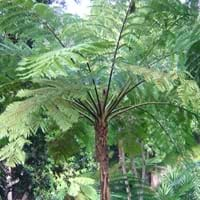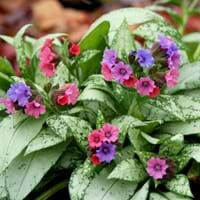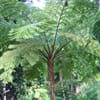Life Span
Perennial
Perennial
Origin
Australia
Hybrid origin
Types
Cyathea cooperi, Dicksonia antarctica
Benediction lungwort, Excalibur lungwort
Number of Varieties
Not Available
Habitat
Shady Edge, Woodland Garden Dappled Shade
Forest edges, Mountains
USDA Hardiness Zone
10-11
4-8
Sunset Zone
H1, H2, 15, 16, 17, 18, 19, 20, 21, 22, 23, 24
1a, 1b, 2a, 2b, 3a, 3b, 4, 5, 6, 7, 8, 9, 14, 15, 16, 17
Habit
Upright/Erect
Cushion/Mound-forming
Flower Color
Not Available
Pink, Rose, Blue Violet
Flower Color Modifier
Bicolor
Not Available
Fruit Color
Not Available
Not Available
Leaf Color in Spring
Light Green, Dark Green
Green, Gray Green, Silver
Leaf Color in Summer
Light Green, Dark Green
Green, Gray Green, Silver
Leaf Color in Fall
Light Green, Dark Green
Green, Gray Green, Silver
Leaf Color in Winter
Light Green, Dark Green
Light Green
Leaf Shape
Fern like
Lung shaped
Plant Season
Spring, Summer, Fall, Winter
Spring, Summer, Fall
Sunlight
Full Sun
Partial Sun, Partial shade, Full Shade
Type of Soil
Clay, Loam, Sand
Clay, Loam, Sand
The pH of Soil
Acidic, Neutral, Alkaline
Acidic, Neutral, Alkaline
Soil Drainage
Average
Well drained
Bloom Time
Not Available
Early Spring, Spring, Late Winter
Tolerances
Wet Site, Salt
Drought
Where to Plant?
Ground
Ground
How to Plant?
Spores
Divison, Seedlings
Plant Maintenance
Medium
Medium
Watering Requirements
Average Water Needs, Do Not over Water, Requires regular watering
Water when soil is dry, when new, water every week
In Summer
Lots of watering
Drought Tolerant
In Spring
Moderate
Average Water
In Winter
Average Water
Adequately
Soil pH
Acidic, Neutral, Alkaline
Acidic, Neutral, Alkaline
Soil Type
Clay, Loam, Sand
Clay, Loam, Sand
Soil Drainage Capacity
Average
Well drained
Sun Exposure
Full Sun
Partial Sun, Partial shade, Full Shade
Pruning
Remove damaged leaves, Remove dead branches, Remove dead leaves, Remove dead or diseased plant parts, Remove deadheads
Remove damaged leaves, Remove dead branches, Remove dead leaves
Fertilizers
10-10-10, Fertilize in early spring, fertilize in fall, fertilize in summer, General purpose liquid or granular fertilizer
All-Purpose Liquid Fertilizer
Pests and Diseases
Red blotch
Powdery mildew, Slugs
Plant Tolerance
Salt, Wet Site
Drought
Flower Petal Number
Single
Single
Foliage Texture
Bold
Coarse
Foliage Sheen
Matte
Matte
Attracts
Birds, Butterflies, Hummingbirds
Not Available
Allergy
Carcinogenic, Thiaminase
Not Available
Aesthetic Uses
Showy Purposes
Showy Purposes
Beauty Benefits
Not Available
Not Available
Environmental Uses
Air purification, soil stabilisation
Air purification, Provides ground cover
Medicinal Uses
Astringent
Astringent, Demulcent, Diaphoretic, Diuretic, Emollient, Exoectorant, Homeopathy, Opthalmic, Resolvent
Part of Plant Used
Leaves, Stem, Tree trunks
Leaves
Other Uses
Showy Purposes
Used for its medicinal properties
Used As Indoor Plant
No
No
Used As Outdoor Plant
Yes
Yes
Garden Design
Container, Feature Plant, Tropical
Edging, Groundcover, Mixed Border, Rock Garden / Wall
Botanical Name
CYATHEA australis
PULMONARIA 'Berries and Cream' PP10597
Common Name
Rough Tree Fern
Berries and Cream Lungwort, Lungwort
In Hindi
Australian Tree Fern
Lungwort
In German
Australian Baumfarn
Lungenkraut
In French
Australian Arbre Fern
pulmonaire
In Spanish
Helecho de árbol australiano
Lungwort
In Greek
Αυστραλιανή Tree Fern
Lungwort
In Portuguese
Australian Tree Fern
pulmonária
In Polish
Australijski Drzewo paproci
płucnik
In Latin
Fern tree Australia
Lungwort
Phylum
Pteridophyta
Ascomycota
Class
Pteridopsida
Ascomycetes
Order
Cyatheales
Peltigerales
Family
Cyatheaceae
Boraginaceae
Clade
Not Available
Angiosperms, Asterids, Eudicots
Tribe
Not Available
Boragineae
Subfamily
Not Available
Boraginoideae
Number of Species
Not Available
Importance of Australian Tree Fern and Lungwort
Want to have the most appropriate plant for your garden? You might want to know the importance of Australian Tree Fern and Lungwort. Basically, these two plants vary in many aspects. Compare Australian Tree Fern and Lungwort as they differ in many characteristics such as their life, care, benefits, facts, etc. Every gardener must at least have the slightest clue about the plants he wants to plant in his garden. Compare their benefits, which differ in many ways like facts and uses. The medicinal use of Australian Tree Fern is Astringent whereas of Lungwort is Astringent, Demulcent, Diaphoretic, Diuretic, Emollient, Exoectorant, Homeopathy, Opthalmic and Resolvent. Australian Tree Fern has beauty benefits as follows: Not Available while Lungwort has beauty benefits as follows: Not Available.
Compare Facts of Australian Tree Fern vs Lungwort
How to choose the best garden plant for your garden depending upon its facts? Here garden plant comparison will help you to solve this query. Compare the facts of Australian Tree Fern vs Lungwort and know which one to choose. As garden plants have benefits and other uses, allergy is also a major drawback of plants for some people. Allergic reactions of Australian Tree Fern are Carcinogenic and Thiaminase whereas of Lungwort have Not Available respectively. Having a fruit bearing plant in your garden can be a plus point of your garden. Australian Tree Fern has no showy fruits and Lungwort has no showy fruits. Also Australian Tree Fern is not flowering and Lungwort is not flowering . You can compare Australian Tree Fern and Lungwort facts and facts of other plants too.





